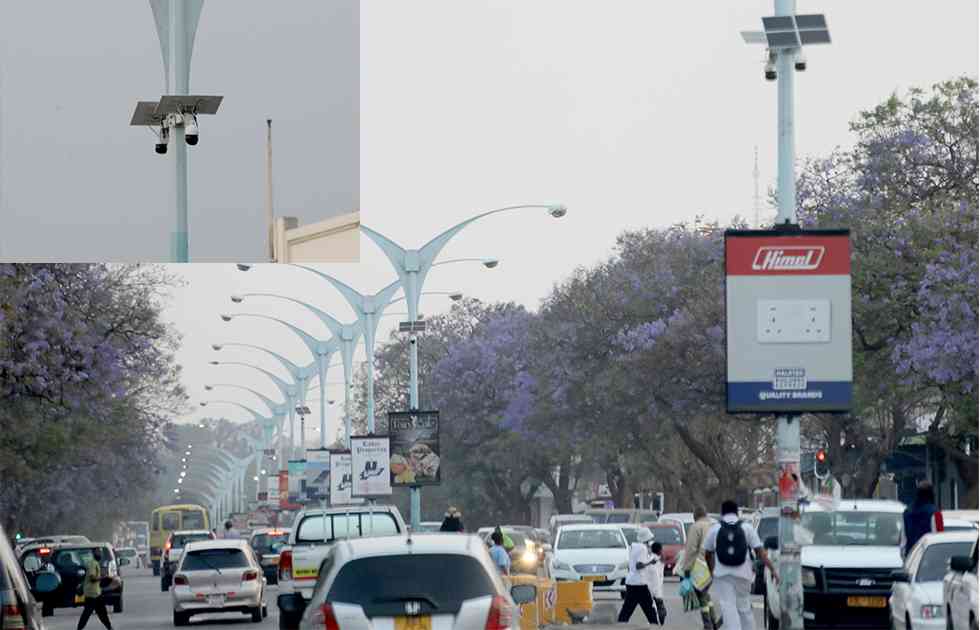
BULAWAYO, Zimbabwe’s second largest city is playing a leading role in engaging Artificial Intelligence in diverse areas it seems. In an earlier article in this column, we observed that CITE, a digital-first media organisation in Bulawayo, had emerged as a pioneer in AI adoption.
They had introduced an AI presenter named “Alice” for their daily news bulletins, significantly streamlining production processes. This innovation had been particularly well-received by younger audiences, suggesting a growing acceptance of AI in news delivery.
Bulawayo has launched a new security initiative incorporating Artificial Intelligence (AI) and CCTV to combat crime. This initiative, part of the Smart City policing strategy, includes facial recognition, night vision, and vehicle plate reading technologies to enhance law enforcement capabilities.
The project is collaboration between the police, the Bulawayo Business Against Crime Forum of Zimbabwe, and Safeguard, a leading security provider in Zimbabwe, aiming to reduce reliance on physical police presence.
The initiative aligns with Zimbabwe’s Vision 2030, focusing on modernising sectors and improving public safety.
The integration of AI in crime prevention offers valuable lessons that can be applied to other regions aiming to leverage technology for public safety.
The role of AI in crime prevention
AI technologies are revolutionising crime prevention by providing law enforcement agencies with sophisticated tools to monitor and respond to criminal activities.
- Harvest hay to prevent veldfires: Ema
- Public relations: How artificial intelligence is changing the face of PR
- Queen Lozikeyi singer preaches peace
- Public relations: How artificial intelligence is changing the face of PR
Keep Reading
In Bulawayo, AI-powered street cameras are being deployed to scan large areas more efficiently than human eyes, alerting law enforcement to potential criminal activities in real time.
These cameras can recognise faces, detect unusual behaviour, and even predict potential threats based on patterns and data analysis.
Implementation in Bulawayo
The implementation of AI in Bulawayo’s crime prevention efforts is part of the city’s smart city surveillance system.
This system integrates various technologies, including AI and Internet of Things (IoT) devices, to create a comprehensive network for monitoring and responding to crime. The city’s police force is adopting these cutting-edge technologies to enhance their capacity to prevent and investigate crimes.
The Chronicle newspaper, last week headlined, “CCTV and AI: A new frontier in Bulawayo’s crime-fight”, while Bulawayo 24.com said, “Police in Bulawayo are set to incorporate cutting-edge technology, including artificial intelligence (AI), to combat crime, marking a significant step toward modernising law enforcement in the city.
“Bulawayo province police spokesperson, Inspector Abednico Ncube, announced that the use of AI, predictive policing, social media forensics, and facial recognition will fundamentally transform how criminal activities are tackled in the digital era.
“Inspector Ncube emphasised that the integration of advanced technology would enhance both preventative and responsive measures, allowing law enforcement agencies to better anticipate, understand, and respond to emerging threats. “This fusion of hard and soft technologies will fortify our efforts in fighting crime,” he said.
Community involvement
In line with these developments, the police also launched the Police Church Partnership (PCPB) on October 1, an initiative aimed at increasing community involvement by fostering collaboration with the church to enhance safety and security across Bulawayo.
One of the key components of the PCPB initiative was the deployment of Closed-Circuit Television (CCTV) cameras across the Central Business District. The CCTV cameras are expected to bolster security by monitoring public and private properties and improving traffic management at intersections controlled by traffic lights.
Official launch
Bulawayo 24.com advised, “The Minister of State for Provincial Affairs and Devolution in Bulawayo, Judith Ncube, has officially launched the Smart City Surveillance System, a significant step in utilising technology to fight crime in the city.
“The surveillance system is a collaborative initiative between the Bulawayo Business Against Crime Forum of Zimbabwe (BACFOZ) and local security agency Safeguard”.
This project marks a major milestone in the city's efforts to embrace modern policing techniques, with law enforcement set to incorporate artificial intelligence (AI) into crime prevention and investigation.
The use of technology is expected to fundamentally change how crime is managed, making it easier to monitor and respond to criminal activities in real-time.
Benefits
AI-powered systems offer enhanced surveillance, providing continuous monitoring of large areas without the need for constant human oversight. This increases the efficiency of surveillance operations and ensures that potential threats are not missed.
In addition to constant monitoring, these systems are capable of generating real-time alerts. When suspicious activities are detected, law enforcement can be notified instantly, allowing for quicker responses to unfolding situations.
Another significant advantage of AI in crime prevention is its ability to process vast amounts of data.
These systems analyse the information to uncover crime patterns and trends, giving law enforcement agencies data-driven insights to improve the allocation of resources.
AI also plays a role in predictive policing by examining historical data and current crime trends to anticipate where future incidents are likely to occur. This allows for proactive strategies, helping to prevent crimes before they happen.
Challenges
While AI offers significant advantages in crime prevention, its implementation comes with several challenges.
One major concern is privacy. The widespread use of surveillance cameras raises important questions about how personal data is handled and the potential for misuse.
There are also technical limitations to consider.
AI systems require a robust infrastructure to function properly and must be continuously maintained to ensure their effectiveness.
Additionally, the ethical implications of using AI in surveillance cannot be ignored. Clear guidelines are necessary to prevent issues like discrimination or bias, ensuring the technology is applied fairly and responsibly.
Lessons learned
Bulawayo’s experience with integrating AI into its crime prevention strategy highlights valuable lessons for other cities.
Collaboration between government agencies, technology providers, and the community is crucial for successful implementation. This cooperative approach ensures that all stakeholders are aligned in their goals and that the technology can be effectively integrated.
Another key takeaway is the importance of infrastructure investment. Advanced technologies like AI require adequate support, meaning cities must invest in the necessary infrastructure to make AI-based crime prevention systems work efficiently.
Lastly, community engagement is vital. By involving the community, cities can build trust and ensure that the technology is used responsibly, addressing concerns and promoting transparency in its application.
Conclusion
The integration of AI in Bulawayo’s crime prevention efforts highlights the transformative potential of technology to improve public safety.
While challenges such as privacy and infrastructure must be addressed, the benefits of AI-driven surveillance and predictive policing are clear.
Bulawayo’s experience underscores the importance of collaboration between governments, technology providers, and communities, as well as the need for robust infrastructure.
As other cities consider adopting similar strategies, they can draw valuable lessons from Bulawayo’s approach, balancing the promise of AI with ethical considerations and community trust.
- Bangure is a filmmaker. He has extensive experience in both print and electronic media production and management. He is a past chairperson of the National Employment Council of the Printing, Packaging and Newspaper Industry. He has considerable exposure to IT networks and Cloud technologies and is an enthusiastic scholar of artificial intelligence. — [email protected].











